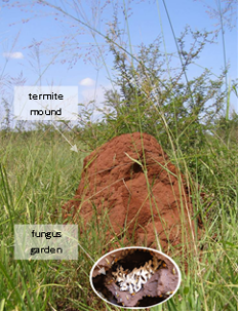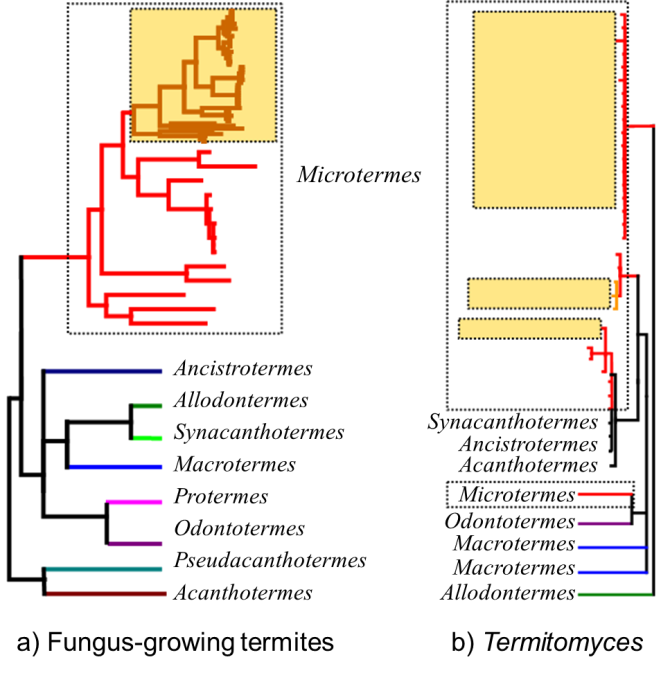Project
Fungus-growing termites - Tania Nobre
The fungus-growing termites are my main study system. They have an obligate mutualism with a basidiomycete fungi of the genus Termitomyces – the termites (Macrotermitidae) cultivate the fungi in fungus gardens!

Tânia Nobre (Post-Doc)
Tel. +31(0)317 483142
E-mail: Tania Mesquita Nobre
Research interests:
- evolutionary origin and stability of symbiosish
- host-symbionts-environment interactions
- co-evolution and speciation
- evolutionary and ecological determinants of species distribution
- population structure and life history evolution


Fungus-growing termites
The fungus-growing termites are my main study system. They have an obligate mutualism with a basidiomycete fungi of the genus Termitomyces – the termites (Macrotermitidae) cultivate the fungi in fungus gardens! The termite’s epigeal nests have a complex architecture that allows for a control environment in temperature and humidity (the nests are just like very organized greenhouses). Thus, the termites offer to their fungus a protected growth environment and the fungi aids the termites in food producing and are themselves high nitrogen rich food. Generally, symbionts are transmitted horizontally (each generation, new foraged spores inoculate the comb) but exceptions exists where the symbiont is transmitted vertically (symbiont inherited from the parental colony).
Origin of the mutualism
Interactions between termites and fungi are found in multiple groups, ranging across both lower and higher termites. However, most of these interactions are usually ephemeral and facultative and are therefore not symbiotic. With one exception, the fungus-growing termites. According to our reconstructions, both of fungus-growing termites and their symbiont, the mutualism originated just before the expansion of the African savannah, about 31 Ma (19–49 Ma). Comparisons between host and fungal symbiont phylogenies show large-scale specificity, but also several recent symbiont sweeps across divergent genera, raising several questions on the dynamics within this mutualism.
Transmission mode and dispersion
Colonisation of new environments is often difficult, particularly for bilateral mutualists: successful dispersal requires partners either to be permanently associated (as in vertical transmission) or to find one another after dispersing separately (as in horizontal transmission). The colonization of Madagascar by this mutualism (showing both transmission modes) is ideal for examining rare colonisations and their evolutionary and ecological consequences. We have shown that vertical transmission provided an advantage for long-distance colonisation as the absence of the right symbionts in a new environment can be a limiting factor for the colonization success of symbioses that rely on horizontal symbiont acquisition.
Population structure
Although vertical transmission has been claimed the main explanation for high levels of partner specificity, paradoxically, the fungal symbionts of fungus-growing termites with this transmission mode are not monophyletic. By studying symbiont population structures we have shown that the pool of fungal symbionts reared and transmitted by a host relying on vertical transmission is not genetically isolated from the symbionts of other host species and that occasional recombination occurs. This raises interesting questions about the coevolutionary potential of fungus-farming in termites. How can we explain these differences in interaction specificity and which factors determine whether specificity will be maintained or lost?
Maintenance of host-symbiont specificity
The high efficiency of fungus-growing termites in digesting plant material has been attributed to their symbiosis with fungi, but the exact role of the fungal symbiont is still debated. We do know that it varies between host species and even between symbiont strains within species. A logical inference is that the demands of the termites on their fungal symbiont to fulfil their nutritional requirements determine the evolution and maintenance of specific interactions. A third party in this mutualism -the bacteria- has been studied much less and its role in mediating specificity has never been addressed.If you are interested in this research theme, to pursue either a masters or undergraduate thesis, you are welcome to contact me!
Selected publications:
Nobre, T. & Aanen, D.K. (2012) Fungiculture or Termite Husbandry? (Invited manuscript) Insects Special issue on Symbiosis: A Source of Evolutionary Innovation in Insects. Insects 2012, 3(1), 307-323; doi:10.3390/insects3010307
Visser, A.; Nobre, T.; Currie, C.R.; Aanen, D.K. & Poulsen, M. (2011) Exploring the potential for Actinobacteria as defensive symbionts in fungus-growing termites. Microbial Ecology. Online first. doi:10.1007/s00248-011-9987-4
Nobre, T., Rouland-Lefèvre, C. & Aanen, D.K. (2011) Comparative biology of fungus-growing ants and termites. In: Biology of termites: a modern synthesis (Eds: D.E. Bignell, Y. Roisin and N. Lo.) Springer 193-210.
Nobre, T.; Koné, N.A.; Konaté, S.; Linsenmair, E.K. & Aanen, D.K. (2011) Dating the fungus-growing termites mutualism shows a mixture between ancient codiversification and recent symbiont dispersal across divergent hosts. Molecular Ecology 20(12): 2619-2627.
Nobre, T.; Fernandes, C; Korb, J; Boomsma, J. & Aanen, D.K. (2011) Farming termites determine the genetic population structure of Termitomyces fungal symbionts. Molecular Ecology 20(9):2023-2033.
Nobre, T.; Eggleton, P. & Aanen, D.K. (2010) Vertical transmission as the key to the colonization of Madagascar by fungus-growing termites? Proceedings of the Royal Society of London B. 277 (1680): 359-365.
Nobre, T.; Nunes, L. & Bignell, D.E. (2009) Survey of subterranean termites (Isoptera: Rhinotermitidae) in a managed silvicultural plantation in Portugal, using a line-intersection method (LIS). Bulletin of Entomological Research 9(1): 11-22.
Nobre, T.; Nunes, L. & Bignell, D.E. (2008) Colony interactions in a termite population assessed by behavioral and molecular genetic methods. Insectes Sociaux 55 (1): 66-73
Nobre, T. (2007). Foraging ecology of Reticulitermes grassei (Clément) with reference to its management as a pest of timber. PhD Thesis. University of London. 213pp. (contact me for a pdf copy)
Nobre, T.; Nunes, L. & Bignell, D.E. (2007). Estimation of foraging territories of Reticulitermes grassei (Clément) through mark-release-recapture. Entomologia Experimentalis et Applicata 123: 119-128.
Nobre, T.; Nunes, L.; Eggleton, P. & Bignell, D.E. (2006). Distribution and genetic variation of Reticulitermes (Isoptera: Rhinotermitidae) in Portugal. Heredity 96(5): 403-409.
Press coverage:
Schone schimmeltuintjes - Bionieuws, April 2010 (in Dutch);
Termites travel with fungi as take-away food - Resource Magazine, October 2009 (in English) followed by an article in the national newspaper The Pers (in Dutch);
Térmitas, uma ameaça - television magazine of scientific divulgation, November 2002 (in Portuguese).For a short biography, please go to my Linkedin webpage.